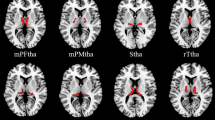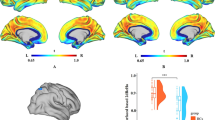Abstract
Cerebellum seems to have a role both in feeding behavior and emotion regulation; therefore, it is a region that warrants further neuroimaging studies in eating disorders, severe conditions that determine a significant impairment in the physical and psychological domain. The aim of this study was to examine the cerebellum intrinsic connectivity during functional magnetic resonance imaging resting state in anorexia nervosa (AN), bulimia nervosa (BN), and healthy controls (CN). Resting state brain activity was decomposed into intrinsic connectivity networks (ICNs) using group spatial independent component analysis on the resting blood oxygenation level dependent time courses of 12 AN, 12 BN, and 10 CN. We extracted the cerebellar ICN and compared it between groups. Intrinsic connectivity within the cerebellar network showed some common alterations in eating disordered compared to healthy subjects (e.g., a greater connectivity with insulae, vermis, and paravermis and a lesser connectivity with parietal lobe); AN and BN patients were characterized by some peculiar alterations in connectivity patterns (e.g., greater connectivity with the insulae in AN compared to BN, greater connectivity with anterior cingulate cortex in BN compared to AN). Our data are consistent with the presence of different alterations in the cerebellar network in AN and BN patients that could be related to psychopathologic dimensions of eating disorders.




Similar content being viewed by others
References
Hopyan T, Laughlin S, Dennis M. Emotions and their cognitive control in children with cerebellar tumors. JINS. 2010;16:1027–38.
Parvizi J, Anderson SW, Martin CO, Damasio H, Damasio AR. Pathological laughter and crying: a link to the cerebellum. Brain. 2001;124:1708–19.
Schmahmann JD. The role of the cerebellum in cognition and emotion: personal reflections since 1982 on the dysmetria of thought hypothesis, and its historical evolution from theory to therapy. Neuropsychol Rev. 2010;20:236–60.
Schmahmann JD, Sherman JC. The cerebellar cognitive affective syndrome. Brain. 1998;121:561–79.
Mahler P, Guastavino JM, Jacquart G, Strazielle C. An unexpected role of the cerebellum: involvement in nutritional organization. Physiol Behav. 1993;54:1063–7.
Zhu J-N, Wang J-J. The cerebellum in feeding control: possible function and mechanism. Cell Mol Neurobiol. 2008;28:469–78.
Saute JAM, da Silva ACF, Souza GN, Russo AD, Donis KC, Vedolin L, et al. Body mass index is inversely correlated with the expanded CAG repeat length in SCA3/MJD patients. Cerebellum. 2012;11:771–4.
Treasure J, Claudino AM, Zucker N. Eating disorders. Lancet. 2010;375:583–93.
Klump KL, Bulik CM, Kaye WH, Treasure J, Tyson E. Academy for eating disorders position paper: eating disorders are serious mental illnesses. Int J Eat Disord. 2009;42:97–103.
Van den Eynde F, Treasure J. Neuroimaging in eating disorders and obesity: implications for research. Child Adolesc Psychiatr Clin N Am. 2009;18:95–115.
Uher R, Murphy T, Brammer MJ, Dalgleish T, Phillips ML, Ng VW, et al. Medial prefrontal cortex activity associated with symptom provocation in eating disorders. Am J Psychiatry. 2004;161:1238–46.
Swayze VW, Andersen AE, Andreasen NC, Arndt S, Sato Y, Ziebell S. Brain tissue volume segmentation in patients with anorexia nervosa before and after weight normalization. Int J Eat Disord. 2003;33:33–44.
Boghi A, Sterpone S, Sales S, D’Agata F, Bradac GB, Zullo G, et al. In vivo evidence of global and focal brain alterations in anorexia nervosa. Psychiatry Res. 2011;192:154–9.
Husain MM, Black KJ, Doraiswamy PM, Shah SA, Rockwell WJ, Ellinwood EH, et al. Subcortical brain anatomy in anorexia and bulimia. Biol Psychiatry. 1992;31:735–8.
Inui A, Asakawa A, Kasuga M, Kamikawa S, Uemoto M, Watanabe T. Paracentral cortical atrophy in patients with eating disorders. Am J Med. 2002;112:681–3.
Pietrini F, Castellini G, Ricca V, Polito C, Pupi A, Faravelli C. Functional neuroimaging in anorexia nervosa: a clinical approach. Eur Psychiatry. 2011;26:176–82.
Suchan B, Busch M, Schulte D, Grönemeyer D, Grönermeyer D, Herpertz S, et al. Reduction of gray matter density in the extrastriate body area in women with anorexia nervosa. Behav Brain Res. 2010;206:63–7.
Seeley WW, Menon V, Schatzberg AF, Keller J, Glover GH, Kenna H, et al. Dissociable intrinsic connectivity networks for salience processing and executive control. J Neurosci. 2007;27:2349–56.
Laird AR, Fox PM, Eickhoff SB, Turner JA, Ray KL, McKay DR, et al. Behavioral interpretations of intrinsic connectivity networks. J Cogn Neurosci. 2011;23:4022–37.
Calhoun VD, Adali T, Pearlson GD, Pekar JJ. A method for making group inferences from functional MRI data using independent component analysis. Hum Brain Mapp. 2001;14:140–51.
McKeown MJ, Makeig S, Brown GG, Jung TP, Kindermann SS, Bell AJ, et al. Analysis of fMRI data by blind separation into independent spatial components. Hum Brain Mapp. 1998;6:160–88.
Garner DM. Eating Disorder Inventory-2 professional manual. Psychological Assessment Resources; 1991.
Garner DM, Olmstead MP, Polivy J. Development and validation of a multidimensional eating disorder inventory for anorexia nervosa and bulimia. Int J Eat Disord. 1983;2:15–34.
Beck AT, Ward CH, Mendelson M, Mock J, Erbaugh J. An inventory for measuring depression. Arch Gen Psychiatry. 1961;4:561–71.
Zuo X-N, Kelly C, Adelstein JS, Klein DF, Castellanos FX, Milham MP. Reliable intrinsic connectivity networks: test–retest evaluation using ICA and dual regression approach. Neuroimage. 2010;49:2163–77.
Allen EA, Erhardt EB, Damaraju E, Gruner W, Segall JM, Silva RF, et al. A baseline for the multivariate comparison of resting-state networks. Front Syst Neurosci. 2011;5:2.
Erhardt EB, Rachakonda S, Bedrick EJ, Allen EA, Adali T, Calhoun VD. Comparison of multi-subject ICA methods for analysis of fMRI data. Hum Brain Mapp. 2010;32:2075–95.
Genovese CR, Lazar NA, Nichols T. Thresholding of statistical maps in functional neuroimaging using the false discovery rate. Neuroimage. 2002;15:870–8.
Buckner RL, Krienen FM, Castellanos A, Diaz JC, Yeo BT. The organization of the human cerebellum estimated by intrinsic functional connectivity. J Neurophysiol. 2011;106(5):2322–45.
Forman SD, Cohen JD, Fitzgerald M, Eddy WF, Mintun MA, Noll DC. Improved assessment of significant activation in functional magnetic resonance imaging (fMRI): use of a cluster-size threshold. Magn Res Med. 1995;33:636–47.
Krienen FM, Buckner RL. Segregated fronto-cerebellar circuits revealed by intrinsic functional connectivity. Cereb Cortex. 2009;19(10):2485–97.
Middleton FA, Strick PL. Cerebellar projections to the prefrontal cortex of the primate. J Neurosci. 2001;21(2):700–12.
Schmahmann JD. Disorders of the cerebellum: ataxia, dysmetria of thought, and the cerebellar cognitive affective syndrome. J Neuropsychiatry Clin Neurosci. 2004;16:367–78.
Konarski JZ, McIntyre RS, Grupp LA, Kennedy SH. Is the cerebellum relevant in the circuitry of neuropsychiatric disorders? J Psychiatry Neurosci. 2005;30:178–86.
Ichimiya T, Okubo Y, Suhara T, Sudo Y. Reduced volume of the cerebellar vermis in neuroleptic-naive schizophrenia. Biol Psychiatry. 2001;49:20–7.
Stanfield AC, McIntosh AM, Spencer MD, Philip R, Gaur S, Lawrie SM. Towards a neuroanatomy of autism: a systematic review and meta-analysis of structural magnetic resonance imaging studies. Eur Psychiatry. 2008;23(4):289–99.
Womer FY, Kalmar JH, Wang F, Blumberg HP. A ventral prefrontal–amygdala neural system in bipolar disorder: a view from neuroimaging research. Acta Neuropsychiatr. 2009;21(6):228–38.
Fang P, Zeng LL, Shen H, Wang L, Li B, Liu L, et al. Increased cortical–limbic anatomical network connectivity in major depression revealed by diffusion tensor imaging. PLoS One. 2012;7(9):e45972.
Drevets WC. Functional neuroimaging studies of depression: the anatomy of melancholia. Annu Rev Med. 1998;49:341–61.
Sacchetti B, Scelfo B, Strata P. Cerebellum and emotional behavior. Neurosci. 2009;162:756–62.
Habas C, Kamdar N, Nguyen D, Prater K, Beckmann CF, Menon V, et al. Distinct cerebellar contributions to intrinsic connectivity networks. J Neurosci. 2009;29:8586–94.
Farrer C, Franck N, Georgieff N, Frith CD, Decety J, Jeannerod M. Modulating the experience of agency: a positron emission tomography study. Neuroimage. 2003;18:324–33.
Delvenne V, Lotstra F, Goldman S, Biver F, De Maertelaer V, Appelboom-Fondu J, et al. Brain hypometabolism of glucose in anorexia nervosa: a PET scan study. Biol Psychiatry. 1995;37:161–9.
Horne RL, Van Vactor JC, Emerson S. Disturbed body image in patients with eating disorders. Am J Psychiatry. 1991;148:211–5.
Uher R, Murphy T, Friederich HC, Dalgleish T, Brammer MJ, Giampietro V, et al. Functional neuroanatomy of body shape perception in healthy and eating-disordered women. Biol Psychiatry. 2005;58(12):990–7.
Gaudio S, Nocchi F, Franchin T, Genovese E, Cannata V, Longo D, et al. Gray matter decrease distribution in the early stages of Anorexia Nervosa restrictive type in adolescents. Psychiatry Res. 2011;191(1):24–30.
Joos A, Hartmann A, Glauche V, Perlov E, Unterbrink T, Saum B, et al. Grey matter deficit in long-term recovered anorexia nervosa patients. Eur Eat Disord Rev. 2011;19(1):59–63.
Kaye W. Neurobiology of anorexia and bulimia nervosa. Physiol Behav. 2008;94:121–35.
Olson IR, Plotzker A, Ezzyat Y. The Enigmatic temporal pole: a review of findings on social and emotional processing. Brain. 2007;130:1718–31.
Liu L, Zeng L-L, Li Y, Ma Q, Li B, Shen H, et al. Altered cerebellar functional connectivity with intrinsic connectivity networks in adults with major depressive disorder. PLoS One. 2012;7:e39516.
Brodal P, Bjaalie JG, Aas JE. Organization of cingulo-ponto-cerebellar connections in the cat. Anat Embryol (Berl). 1991;184(3):245–54.
Schmahmann JD, Pandya DN. Prefrontal cortex projections to the basilar pons in rhesus monkey: implications for the cerebellar contribution to higher function. Neurosci Lett. 1995;199(3):175–8.
Joos AAB, Saum B, Zeeck A, Perlov E, Glauche V, Hartmann A, et al. Frontocingular dysfunction in bulimia nervosa when confronted with disease-specific stimuli. Eur Eat Disord Rev. 2011. doi:10.1002/erv.1150.
Fassino S, Abbate-Daga G, Amianto F, Facchini F, Rovera GG. Eating psychopathology and personality in eating disorders. Epidemiol Psichiatr Soc. 2003;12:293–300.
Fassino S, Abbate-Daga G, Amianto F, Leombruni P, Boggio S, Rovera GG. Temperament and character profile of eating disorders: a controlled study with the Temperament and Character Inventory. Int J Eat Disord. 2002;32:412–25.
Lock J, Garrett A, Beenhakker J, Reiss AL. Aberrant brain activation during a response inhibition task in adolescent eating disorder subtypes. Am J Psychiatry. 2011;168(1):55–64.
Schienle A, Schafer A, Hermann A, Vaitl D. Binge-eating disorder: reward sensitivity and brain activation to images of food. Biol Psychiatry. 2009;65(8):654–61.
Marsh R, Steinglass JE, Gerber AJ, Graziano O’Leary K, Wang Z, Murphy D, et al. Deficient activity in the neural systems that mediate self-regulatory control in bulimia nervosa. Arch Gen Psychiatry. 2009;66(1):51–63.
Rolls ET. Taste, olfactory and food texture reward processing in the brain and the control of appetite. Proc Nutr Soc. 2012;71(4):488–501.
Craig AD. Significance of the insula for the evolution of human awareness of feelings from the body. Ann N Y Acad Sci. 2011;1225:72–82.
Wagner A, Aizenstein H, Mazurkewicz L, Fudge J, Frank GK, Putnam K, et al. Altered insula response to taste stimuli in individuals recovered from restricting-type anorexia nervosa. Neuropsychopharmacology. 2008;33:513–23.
Zhu J-N, Yung W-H, Kwok-Chong Chow B, Chan Y-S, Wang J-J. The cerebellar–hypothalamic circuits: potential pathways underlying cerebellar involvement in somatic–visceral integration. Brain Res Rev. 2006;52:93–106.
Hoppenbrouwers SS, Schutter DJLG, Fitzgerald PB, Chen R, Daskalakis ZJ. The role of the cerebellum in the pathophysiology and treatment of neuropsychiatric disorders: a review. Brain Res Rev. 2008;59:185–200.
Frank GK. Advances in the diagnosis of anorexia nervosa and bulimia nervosa using brain imaging. Expert Opin Med Diagn. 2012;6(3):235–44.
Acknowledgment
The present paper is a publication sponsored by the “Compagnia di San Paolo” Bank Foundation with the Grant “Bando Neuroscienze” (code 3929IT/PF 2008.2242) assigned in 2009 to Prof. Secondo Fassino and Dr. Federico Amianto.
Conflict of Interest
The authors declare that potential conflicts of interest do not exist.
Author information
Authors and Affiliations
Corresponding author
Additional information
D’Agata and Amianto equally contributed to this work.
Electronic Supplementary Material
ESM 1
(DOC 2.12 mb)
Rights and permissions
About this article
Cite this article
Amianto, F., D’Agata, F., Lavagnino, L. et al. Intrinsic Connectivity Networks Within Cerebellum and Beyond in Eating Disorders. Cerebellum 12, 623–631 (2013). https://doi.org/10.1007/s12311-013-0471-1
Published:
Issue Date:
DOI: https://doi.org/10.1007/s12311-013-0471-1




